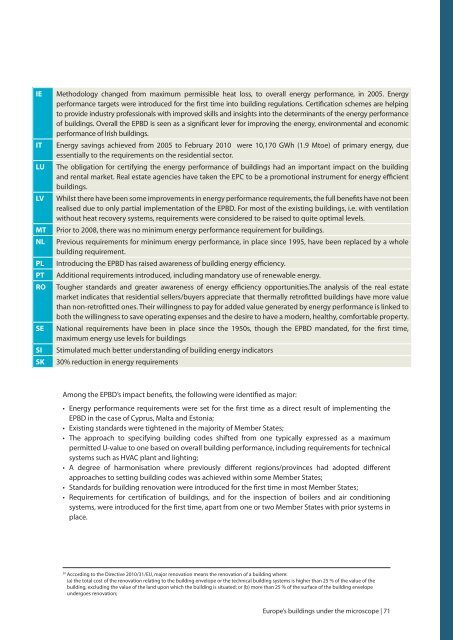BPIE: Europe's buildings under the microscope - PU Europe
BPIE: Europe's buildings under the microscope - PU Europe
BPIE: Europe's buildings under the microscope - PU Europe
You also want an ePaper? Increase the reach of your titles
YUMPU automatically turns print PDFs into web optimized ePapers that Google loves.
IE<br />
IT<br />
LU<br />
LV<br />
MT<br />
NL<br />
PL<br />
PT<br />
RO<br />
SE<br />
SI<br />
SK<br />
Methodology changed from maximum permissible heat loss, to overall energy performance, in 2005. Energy<br />
performance targets were introduced for <strong>the</strong> first time into building regulations. Certification schemes are helping<br />
to provide industry professionals with improved skills and insights into <strong>the</strong> determinants of <strong>the</strong> energy performance<br />
of <strong>buildings</strong>. Overall <strong>the</strong> EPBD is seen as a significant lever for improving <strong>the</strong> energy, environmental and economic<br />
performance of Irish <strong>buildings</strong>.<br />
Energy savings achieved from 2005 to February 2010 were 10,170 GWh (1.9 Mtoe) of primary energy, due<br />
essentially to <strong>the</strong> requirements on <strong>the</strong> residential sector.<br />
The obligation for certifying <strong>the</strong> energy performance of <strong>buildings</strong> had an important impact on <strong>the</strong> building<br />
and rental market. Real estate agencies have taken <strong>the</strong> EPC to be a promotional instrument for energy efficient<br />
<strong>buildings</strong>.<br />
Whilst <strong>the</strong>re have been some improvements in energy performance requirements, <strong>the</strong> full benefits have not been<br />
realised due to only partial implementation of <strong>the</strong> EPBD. For most of <strong>the</strong> existing <strong>buildings</strong>, i.e. with ventilation<br />
without heat recovery systems, requirements were considered to be raised to quite optimal levels.<br />
Prior to 2008, <strong>the</strong>re was no minimum energy performance requirement for <strong>buildings</strong>.<br />
Previous requirements for minimum energy performance, in place since 1995, have been replaced by a whole<br />
building requirement.<br />
Introducing <strong>the</strong> EPBD has raised awareness of building energy efficiency.<br />
Additional requirements introduced, including mandatory use of renewable energy.<br />
Tougher standards and greater awareness of energy efficiency opportunities.The analysis of <strong>the</strong> real estate<br />
market indicates that residential sellers/buyers appreciate that <strong>the</strong>rmally retrofitted <strong>buildings</strong> have more value<br />
than non-retrofitted ones. Their willingness to pay for added value generated by energy performance is linked to<br />
both <strong>the</strong> willingness to save operating expenses and <strong>the</strong> desire to have a modern, healthy, comfortable property.<br />
National requirements have been in place since <strong>the</strong> 1950s, though <strong>the</strong> EPBD mandated, for <strong>the</strong> first time,<br />
maximum energy use levels for <strong>buildings</strong><br />
Stimulated much better <strong>under</strong>standing of building energy indicators<br />
30% reduction in energy requirements<br />
Among <strong>the</strong> EPBD’s impact benefits, <strong>the</strong> following were identified as major:<br />
• Energy performance requirements were set for <strong>the</strong> first time as a direct result of implementing <strong>the</strong><br />
EPBD in <strong>the</strong> case of Cyprus, Malta and Estonia;<br />
• Existing standards were tightened in <strong>the</strong> majority of Member States;<br />
• The approach to specifying building codes shifted from one typically expressed as a maximum<br />
permitted U-value to one based on overall building performance, including requirements for technical<br />
systems such as HVAC plant and lighting;<br />
• A degree of harmonisation where previously different regions/provinces had adopted different<br />
approaches to setting building codes was achieved within some Member States;<br />
• Standards for building renovation were introduced for <strong>the</strong> first time in most Member States;<br />
• Requirements for certification of <strong>buildings</strong>, and for <strong>the</strong> inspection of boilers and air conditioning<br />
systems, were introduced for <strong>the</strong> first time, apart from one or two Member States with prior systems in<br />
place.<br />
30<br />
According to <strong>the</strong> Directive 2010/31/EU, major renovation means <strong>the</strong> renovation of a building where:<br />
(a) <strong>the</strong> total cost of <strong>the</strong> renovation relating to <strong>the</strong> building envelope or <strong>the</strong> technical building systems is higher than 25 % of <strong>the</strong> value of <strong>the</strong><br />
building, excluding <strong>the</strong> value of <strong>the</strong> land upon which <strong>the</strong> building is situated; or (b) more than 25 % of <strong>the</strong> surface of <strong>the</strong> building envelope<br />
<strong>under</strong>goes renovation;<br />
<strong>Europe</strong>’s <strong>buildings</strong> <strong>under</strong> <strong>the</strong> <strong>microscope</strong> | 71
















